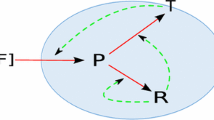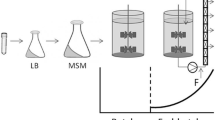Abstract
A mathematical model of microbial cultivation is developed that describes the emergence of biomass oscillations under continuous conditions with a period shorter than the culture generation time. The model constants at which the calculation results are in the best agreement with experimental data are found. The phase portrait of the system in the oscillation mode is analyzed. The possibility of using the model for describing the behavior of different cultures in different modes is demonstrated.
Similar content being viewed by others
Abbreviations
- b:
-
fraction of the substrate entering the cell that is consumed to form intermediates (during substrate transport)
- C e :
-
mass concentration of transport enzymes E in the σ phase, mg/mg
- C es :
-
mass concentration of complex ES in the σ phase, mg/mg
- C l :
-
mass concentration of intermediates in the cell, mg/mg
- \(\bar C_l \) :
-
steady-state mass concentration of intermediates, mg/mg
- \(\tilde C_l \) :
-
critical mass concentration of intermediates at which the development of bioerrors and cell inactivation are activated, mg/mg
- C x :
-
mass concentration of macromolecular components X in phase II, mg/mg
- C y :
-
mass concentration of complex XL in phase II, mg/mg
- D:
-
dilution rate, h−1
- D cr :
-
critical dilution rate at which biomass oscillations begin, h−1
- E:
-
membrane enzymes catalyzing transport
- ES:
-
intermediate enzyme-substrate complex forming during substrate transport
- F:
-
rate of lysis of pathogenic cells, mg/(1 h)
- g:
-
mass fraction of low-molecular-weight components (substrate and intermediates) in substrate transport and synthesis of macromolecules
- g′, g″:
-
stoichiometric coefficients in reactions of the model of the microlevel
- j:
-
total fictitious flux of substrate supply into the σ phase, mg/(1 h)
- k n :
-
rate constant for the nth reaction in the cell (n = 2−7), h−1
- k −n :
-
rate constant for the intracellular reaction that is reverse to the nth reaction (n = 1, 5), h−1
- k s :
-
specific mass-transfer coefficient of the substrate, l/(mg h)
- L:
-
monomeric intermediates
- S:
-
limiting carbon-containing substrate
- t:
-
time, h
- u:
-
fraction of intermediates consumed by the cell for synthesis of macromolecules
- W n :
-
rate of the nth reaction in the cell (n = 1−7), h−1
- W −n :
-
rate of the intracellular reaction that is reverse to the nth reaction (n = 1, 5), h−1
- X:
-
macromolecular cellular components (enzymes, proteins, DNA, RNA, etc.)
- XL:
-
intermediate complex forming during synthesis of macromolecular components
- Z:
-
biomass, mg/l
- \(\bar Z\) :
-
steady-state biomass concentration, mg/l
- Z M :
-
pathogenic biomass, mg/l
- Z V :
-
viable biomass, mg/l
- Z 0 :
-
biomass concentration at the initial moment of time, g/l
- α:
-
fraction of viable cells
- γ:
-
mass fraction of the products of lysis of the pathogenic biomass that can be consumed by viable cells as a substrate
- μ:
-
specific biomass growth rate, h−1
- ρi :
-
average density of phase i, i.e., the ratio of the total weight of the phase to the volume of the system, mg/l
- ρs :
-
residual substrate concentration, mg/l
- ρ 0s :
-
substrate concentration in the nutrient solution, mg/l
- ρɛ :
-
average CO2 density in phase I, mg/l
- τ:
-
time lag, i.e., time required to prepare the inactivation mechanism, h
- υi :
-
specific rate of growth of phase i, h−1
- χ:
-
specific rate of development of bioerrors on the scale of a cell population, h−1
- i:
-
phase
- σ:
-
σ phase
- ϕ:
-
phase II
References
Kvasnikov, E.I. and Klyushnikova, T.M., (Oil-Degrading Microorganisms in Water Basins), Kiev: Naukova Dumka, 1981.
Kapotina, L.N., Morshchakova, G.N., and Dedovets, S.A., Method for Removing Hydrocarbons of Petroleum and Oils from Environmental Objects, RF Patent 2115727, 1998.
Zvyagintseva, I.S., Surovtseva, E.G., Poglazova, M.N., Ivoilov, V.S., and Belyaev, S.S., Degradation of Machine Oil by Nocardioform Bacteria, Mikrobiologiya, 2001, vol. 70, no. 3, pp. 321–327 [Microbiology (Engl. Transl.), vol. 70, no. 3, pp. 270–276].
Januska, V. and Lugauskas, A., Petroleum Oil and Its Products Decomposing Microorganism Arthrobacter globiformis md18, Lithuania Patent 98146, 1999.
Plotnikova, E.G., Altyntseva, O.V., Kosheleva, I.A., Puntus, I.F., Filonov, A.E., Gavrish, E.Yu., Demakov, V.A., and Boronin, A.M., Bacterial Degraders of Polycyclic Aromatic Hydrocarbons Isolated from Salt-Contaminated Soils and Bottom Sediments in Salt Mining Areas, Mikrobiologiya, 2001, vol. 70, no. 1, pp. 61–68 [Microbiology (Engl. Transl.), vol. 70, no. 1, pp. 51–58].
Markusheva, T.V., Zhurenko, E.Yu., Sultanbekova, M.N., et al., Bacterial Strain Arthrobacter globiformis Performing Biological Degradation of Phenol and 2,4-Dichlorophenol, RF Patent 2076523, 2000.
Kvasnikov, E.I. and Pisarchuk, E.N., Artrobakter v prirode i proizvodstve (Arthrobacter in Nature and Technology), Kiev: Naukova Dumka, 1980.
Zaitsev, G.M. and Karasevich, Yu.N., Utilization of 4-Chlorobenzoic Acid by Arthrobacter globiformis, Mikrobiologiya, 1981, vol. 50, no. 1, p. 35.
Itoh, K., Kitade, Y., Kobayashi, S., et al., Demethylation of Acridine Orange by Arthrobacter globiformis, Bull. Environ. Contam. Toxicol., 1998, vol. 60, no. 5, p. 781.
Polatovskaya, O.G., Barabanshchikova, G.V., Malkov, M.A., et al., Bacterial Strain Arthrobacter globiformis As a Coproporphyrin III Producer and Coproporphyrin III Production Method, RF Patent 2078 138, 1997.
Bykhovskii, V.Ya., Zaitseva, N.I., Mironov, A.F., Osin, N.S., Pecherskikh, E.V., Rumyantseva, V.D., and Sukhin, G.M., Coproporphyrins, Uroporphyrins, and Their Metal Complexes: Biosynthesis and Application to Immune Analysis and Diagnostic Methods, 2001, vol. 37, no. 6, pp. 660–667 [Appl. Biochem. Microbiol. (Engl. Transl.), vol. 70, no. 1, pp. 561–568].
Gachok, V.P., Kinetika biokhimicheskikh protsessov (Kinetics of Biochemical Processes), Kiev: Naukova Dumka, 1988.
Fokina, V.V., Arinbasarova, A.Yu., Zubov, A.L., et al., Dehydration of Steroid Substrates by Bacterial Cells Arthrobacter globiformis 193 Included in Polyvinyl Alcohol Cryogel, Prikl. Biokhim. Mikrobiol., 1995, vol. 31, no. 2, p. 213.
Izumori, K. and Sakai, S., Method for Determining Galactitol, US Patent 4923803, 1990.
Panikov, N.S., Kinetika rosta mikroorganizmov (Kinetics of Microbial Growth), Moscow: Nauka, 1991.
Dorofeev, A.G, Glagolev, M.V., Bondarenko, T.F., and Panikov, N.S., Unusual Kinetics of Growth of Arthrobacter globiformis and Its Explanation, Mikrobiologiya, 1992, vol. 61, no. 1, p. 33.
Panikov, N.S., Mechanistic Mathematical Models of Microbial Grows in Bioreactors and in Natural Soils: Explanation of Complex Phenomena, Math. Comput. Simulat., 1996, vol. 42, p. 179.
Domach, M.M., Leung, S.K., Cahn, R.E., et al., Computer Model for Glucose-Limited Growth of a Single Cell of Escherichia coli, Biotechnol. Bioeng., 1984, vol. 26, no. 2, p. 203.
Drozdov-Tikhomirov, L.N. and Rakhimova, N.T., Mathematic Model of Transient Processes in a Chemostatic Culture of Microorganisms, Mol. Biol., 1985, vol. 19, no. 3, p. 751.
Skichko, A.S., Modeling and Optimization of Bacterial Cultivation in Bioreactors, Cand. Sci. (Eng.) Dissertation, Moscow: Mendeleev Univ. Chem. Technol. Russ., 2002.
Skulachev, V.P., I Suppose That a “Samurai Law” Acts in Biology, Komp’yuterra, 2001, no. 7, p. 46.
Kolpakov, A.I., Il’inskaya, O.N., Bespalov, M.M., Kupriyanova-Ashina, F.G., Gal’chenko, V.F., Kurganov, B.I., and El’-Registan, G.I., Stabilization of Enzymes by Dormancy Autoinducers as a Possible Mechanism of Resistance of Resting Microbial Forms, Mikrobiologiya, 2000, vol. 69, no. 2, pp. 224–229 [Microbiology (Engl. Transl.), vol. 69, no. 2, pp. 180–185].
Demkina, E.V., Soina, V.S., El’-Registan, G.I., and Zvyagintsev, D.G., Reproductive Resting Forms of Arthrobacter globiformis, Mikrobiologiya, 2000, vol. 69, no. 3, pp. 377–382 [Microbiology (Engl. Transl.), vol. 69, no. 3, pp. 309–313].
Author information
Authors and Affiliations
Additional information
Original Russian Text © A. S. Skichko, E. M. Kol’tsova, 2006, published in Teoreticheskie Osnovy Khimicheskoi Tekhnologii, 2006, Vol. 40, No. 5, pp. 540–550.
Rights and permissions
About this article
Cite this article
Skichko, A.S., Kol’tsova, E.M. Mathematical model for describing oscillations of bacterial biomass. Theor Found Chem Eng 40, 503–513 (2006). https://doi.org/10.1134/S0040579506050071
Received:
Issue Date:
DOI: https://doi.org/10.1134/S0040579506050071




